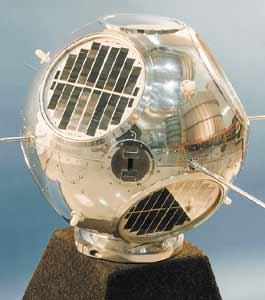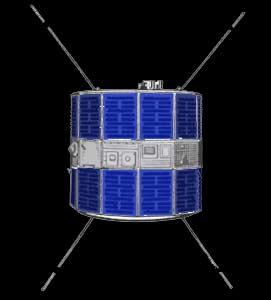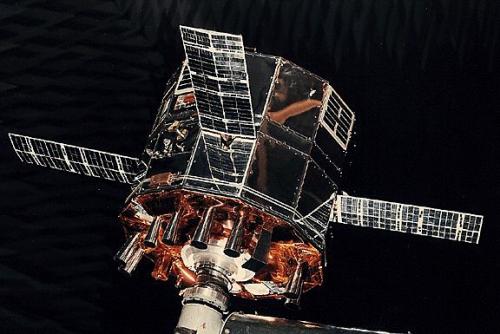Solrad
The Solrad series of satellites were sponsored by the US Navy in a program to continuously monitor the Sun. The satellites investigated solar X-rays and particle emissions which cause disturbances in the ionosphere. They were also called Galactic Radiation Experiment Background (GREB) or Sunray and the information gathered enabled an assessment of the disturbances on satellite and ground based communications.
In 1998 it was revealed that the early satellites also carried a signal intelligence payload to interrogate USSR air defense radars. This payload was known as Galactic Radiation and Background (GRAB) and had the code name Poppy, later changed to Dyno. It involved only a few of the Solrad series of satellites and later satellites in the series appear to be of a pure scientific nature.
| Name | Intl. Designation | Launch | Re-entry | Notes |
|---|---|---|---|---|
| Solrad-1 | 1960 η2 | 22-Jun-1960 | ||
| Solrad-2 | --- | 30-Nov-1960 | --- | Failed to orbit |
| Solrad-3 | 1961 ο2 | 29-Jun-1961 | Failed to separate from Injun-1 | |
| Solrad-4A | --- | 24-Jan-1962 | --- | Failed to orbit |
| Solrad-4B | --- | 26-Apr-1962 | --- | Failed to orbit |
| Solrad-5A | (No data) | |||
| Solrad-5B | 1964-001E | 11-Jan-1964 | ||
| Solrad-6A | 1963-021C | 15-Jun-1963 | 1-Aug-1963 | |
| Solrad-6B | 1965-016A | 9-Mar-1965 | Also known as Ferret-12 and Ops-4988 | |
| Solrad-7A | 1964-001D | 11-Jan-1964 | ||
| Solrad-7B | 1965-016D | 9-Mar-1965 | ||
| Solrad-8 | 1965-093A | 19-Nov-1965 | Also known as Explorer-30 | |
| Solrad-9 | 1968-017A | 5-Mar-1968 | 16-Nov-1990 | Also known as Explorer-37 |
| Solrad-10 | 1971-058A | 8-Jul-1971 | 15-Dec-1979 | Also known as Explorer-44 |
| Solrad-11A | 1976-023C | 15-Mar-1976 | ||
| Solrad-11B | 1976-023D | 15-Mar-1976 | ||
Launch dates of the Solrad series
Solrad-1 studied, in particular, the hydrogen Lyman-alpha and X-ray radiation continuously over a period of time. For these purposes it carried two Lyman-alpha ionisation chambers and an X-ray ionisation chamber.
 |
| Photo: Author's collection |
| Solrad-1 (1960 η2) |
Solrad-2 was identical to Solrad-1 but was destroyed by the range safety officer on launch.
Solrad-3 used two X-ray sensors and a detector to measure solar X-ray emissions to plot how the solar X-rays disturb the ionosphere and to seek basic data on the cause of radio black-outs on Earth during periods of solar flare activity. It was launched simultaneously with the Transit-4A and Injun-1 satellites, but remained attached to Injun-1.
Solrad-4A was part of a payload of five satellites, sometimes referred to as Composite-1 and which failed to attain orbit due to the malfunction of the second stage of the launch vehicle. The satellite, which was to continue the study of X-rays and Lyman-alpha radiation from the Sun, carried four Lyman-alpha detectors and four X-ray detectors. Solrad-4B, which was identical to Solrad-4A, also failed to achieve orbit.
Solrad-5B (there is no information on Solrad-5A) provided data to establish basic minimum energy flux during the absence of solar flares. It carried five photometers to measure the X-ray emission and one photometer to measure ultraviolet radiation.
Solrad-6A, which was launched before Solrad-5B, was equipped with four X-ray detectors and four Lyman-alpha detectors. Solrad-6B repeated the experiments and objectives of Solrad-6A.
Both Solrad-7A and -7B monitored the solar activity and provided data to establish the basic minimum energy flux during the absence of solar flares. They carried each five photometers to measure X-ray emissions in various bands and one photometer to measure ultraviolet radiation.
Solrad-8, also known as Explorer-30, was launched as part of the International Year of the Quiet Sun. It monitored solar X-rays and readings were correlated with ground observations. It carried ion chambers and Geiger-Müller counters for the measurement of X-rays and ultraviolet radiation.
Solrad-9, also known as Explorer-37, carried five X-ray photometers, two ultraviolet photometers and two Geiger-Müller counters to measure and monitor selected solar X-ray and ultraviolet emissions.
 |
| Photo: Author's collection |
| Solrad-9 (1968-017A) |
Solrad-10, also referred to as Explorer-44, continued to monitor the solar radiation and also measured stellar radiation from other celestial sources. It carried fourteen experiments, including:
- eighteen ionisation chambers for solar X ray monitoring
- a solar electron temperature gauge
- a solar Lyman alpha burst monito
- a solar ultraviolet monitor
- an instrument to study the solar ultraviolet continuum flash
- an instrument to record the background X ray levels
- an instrument to measure the solar hard X ray continuum
- a CsI scintillating crystal and photo multiplyer
- a LiF photometer for solar excitation of the F layer
- a thermistor to measure skin anti solar temperature
- a large area proportional counter
 |
| Photo: Author's collection |
| Solrad-10 (1971-058A) |
Solrad-11A and -11B were two identical satellites which were launched simultaneously and were placed in an orbit with an altitude of about 20 Earth radii to provide real time monitoring of solar X-rays, as well as ultraviolet and energetic particle emissions. The payload included:
- broadband ion chambers observing solar X rays between 0.1 and 60 Angstrom
- proportional counters and scintillators observing solar X rays between 2 and 150 keV
- an EUV detector covering three bands between 170 and 1000 Angstrom
- a variable resolution Ebert-Fastie spectrometer covering the wavelength range of 1100 to 1600 Angstrom
- a solar wind monitor, solar proton, electron, and Alpha particle monitors
- two X-ray polarimeters (one utilizing Bragg scattering and the other utilizing Thompson scattering)
- a Bragg spectrometer observing magnesium-11 and -12 lines
- a large-area auroral X-ray detector
- a passively cooled solid-state X-ray detector to measure background X-ray emissions
 |
| Photo: Author's collection |
| Solrad-11A (1976-023C) |
Solrad-11A and Solrad-11B were spaced 180° apart. A third satellite in the series was constructed but was not launched.
Back to Directory of U.S. Military Rockets and Missiles, Appendix 3
Last Updated: 12 April 2005